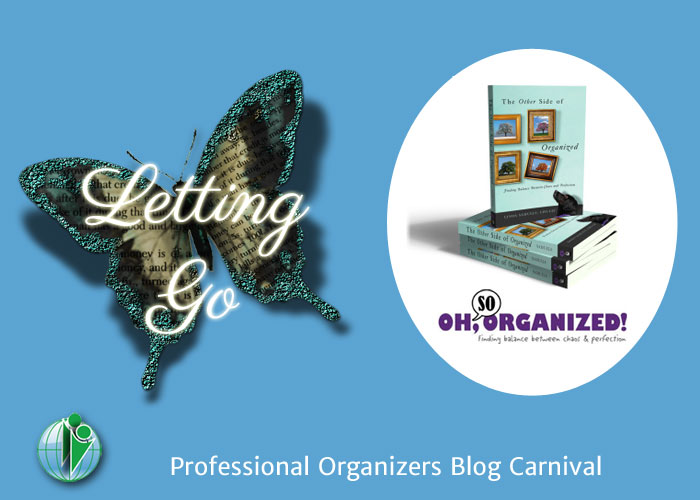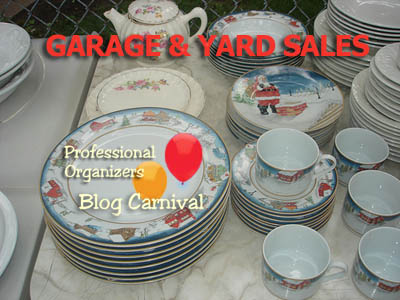Letting Go through Story Telling
This page may contain links to Amazon.com or other sites from which I may receive commission on purchases you make after clicking on such links. Read my full Disclosure Policy

One of the things I found most challenging about residential organizing was helping clients decide which mementos were worth saving. Perhaps it’s because I have a tendency to form a sentimental attachment to certain objects myself. I probably acquired this trait from my mother, though whether through genetics or exposure, I’ll never know.
Clients are often advised to take a picture of such things and to pass the items themselves on to someone who can make use of or enjoy them. Although this can be a viable solution, a picture doesn’t always capture the feelings associated with the original object. Take the above photo as an example. What do you see? Probably nothing more than a bunch of old buttons.
I took this picture just before handing those buttons over to a local woman who was planning to use some of them in a number of different projects. When I responded to her request on a Recycling Kindness group on Facebook, my intention was to let her choose a few so I could keep my “collection.” After a gentle nudge from my husband, I realized I was ready to let them all go, especially since I actually had to check whether I still had them before replying to her post.
As I fondly looked at the collection for the last time, I realized why a picture wasn’t going to satisfy me: it wasn’t the collection itself that I’m attached to; it was the story behind it. So I decided to write the story of my button collection.
When I went to Gramma’s house as a little girl, sometimes she would bring out a green tin filled with buttons and other trinkets. I probably spent hours sorting those buttons by color, size, and style, but the best part was coming upon special ones like the brown leathery ones at the top and bottom of the photo. Gramma died when I was nine, and the button tin came to live at our house, and I continued to enjoy it with my mother.
After I’d grown up, I bought an old house which had been in the same family for generations. The house went on the market when the last surviving family member moved into a nursing home at age 90. Some of the contents were sold, but much was left behind – including a large assortment of old buttons which were still on the original cards from the sewing shop. At some point, I took them off the cards and sorted them into one of those drawer units that are typically used for organizing nails and screws.
When my Mom passed away, the green button tin came to live at my house. Eventually I removed the trinkets and placed them in my own “treasure box;” discarded the tin, which had become a bit rusty with age, as well as the drawer unit, and tossed all the buttons into a larger biscuit tin, where they’ve been sitting ever since.
It’s not much of a story, but it has now been preserved for posterity. Perhaps some day I can tell it to my grandchildren, and who knows, maybe someday they will be telling it to me.
Want to talk to colleagues about your favorite organizing strategies – or anything else?
Join the POPS Circle, where organizing and productivity professionals share ideas, experiences, and encouragement.
I think this would be a wonderful way for your clients to preserve and pass on their memories, without holding on to things that are only seen when it’s time to clean out the closet. Some might even like to incorporate their pictures and stories into a scrapbook. Others might enjoy writing a longer, more detailed story. Those who don’t like to write could perhaps make a video of themselves with the treasured object, while telling the story behind it.
Story telling can keep the memories behind precious keepsakes alive long after the items are gone.
Have you used this strategy with any of your clients?



I have, indeed, suggested to clients that they take photos of sentimental items, if they are on the verge of being able to let them go and have decided they’d like to downsize the space (physical, emotional) that they occupy. But I like the idea of telling the story behind the photo, too, and will keep that in mind for next time.
If you do, I’d love to know how it goes!
What a wonderful memory that you’ve written about! It’s those special times that hold the warm fuzzies of life for us.
When working with an adult male a while back, he had a collection of teddy bears that needed to go, so I took a photo of them that he used as a screen saver to remember his furry family.
We are an interesting species with our special memories.
A screensaver – what a great idea! It’s too easy to lose sight of photos, especially now that they’re mostly digital. Thanks for sharing!
I enjoyed reading about your memories of those buttons, Janet. I hope you’ll write down some more of them – inspired by objects, photos, or just what’s up there in your head.
Thanks for the nudge – that would be a great pastime for me!
Hazel shared this post on her Facebook page, and there’s some more interesting discussion going on there – check it out at https://www.facebook.com/org4life/posts/294345664006867
I loved this post! Just in time for me to try it on a new client that is having difficulty letting go of her Mom’s stuff. Also, I have been recently thinking about this very subject and how I manage this issue with clients. Perfect! Thanks!
That’s great! Please let me know how it works out with your client.
Yes, I have Janet. Storytelling naturally happens with my more verbal clients and it does seem to help them let go of sentimental items. I enjoy the stories also. By the way, my mom had a coffee can filled with buttons. As she worked on her sewing projects, I would entertain myself stringing the buttons with a needle and thread. It’s a lovely memory for me. The buttons were donated when they moved out of their house 7 years ago.
Aw, it’s nice that we have some similar childhood memories!
I’m sure your clients appreciate your ability to listen to and enjoy their stories.
I enjoyed your story, Janet! It made me think that offering a small journal to my clients who have lots of special treasures might be a good idea. They would have someplace to put their story! And it wouldn’t have to be long. Just enough to capture why it is special. And if they can’t think of a story–perhaps it isn’t really a treasure after all. 🙂
I love that idea, Olive! You could even put your branding on it so they’ll think of you the next time they’re going through their “stuff.”
And now there’s an app for that last sentence — Those who don’t like to write could perhaps make a video of themselves with the treasured object, while telling the story behind it — Keepy!
You’re so right – that’s brilliant!
Great post! The story behind the item is really the most important thing. I find that many of my clients are more willing to let go of something after they’ve told their story. As you did in this post, I think writing down the story to preserve the memories is a wonderful idea.
Thanks, Nancy. I really enjoyed writing my story.
Thank you for this story, Janet. I was writing a short speech on Releasing Sentimental Objects and needed a tale to illustrate this point. Many clients have told me stories about their belongings before they let go, but I don’t recall the stories! So I am using your story to illustrate the point that sometimes telling (or recording) the story one more time allows one to let go of a sentimental object.
Thanks for letting me know! When I posted this, I worried that any organizer would know this stuff, and wondered if they’d even find value in it. It makes me very happy that it was helpful to an experienced organizer like you!